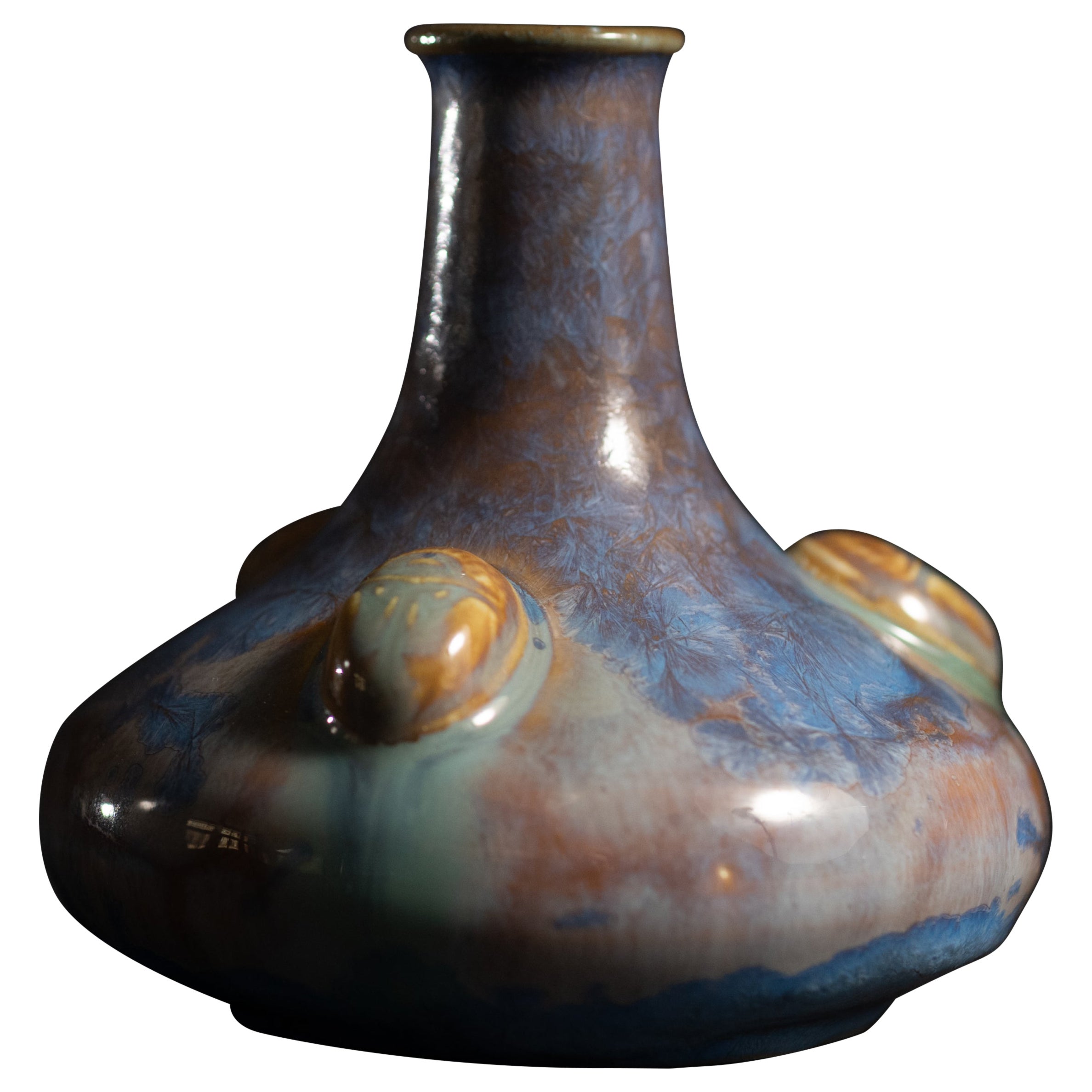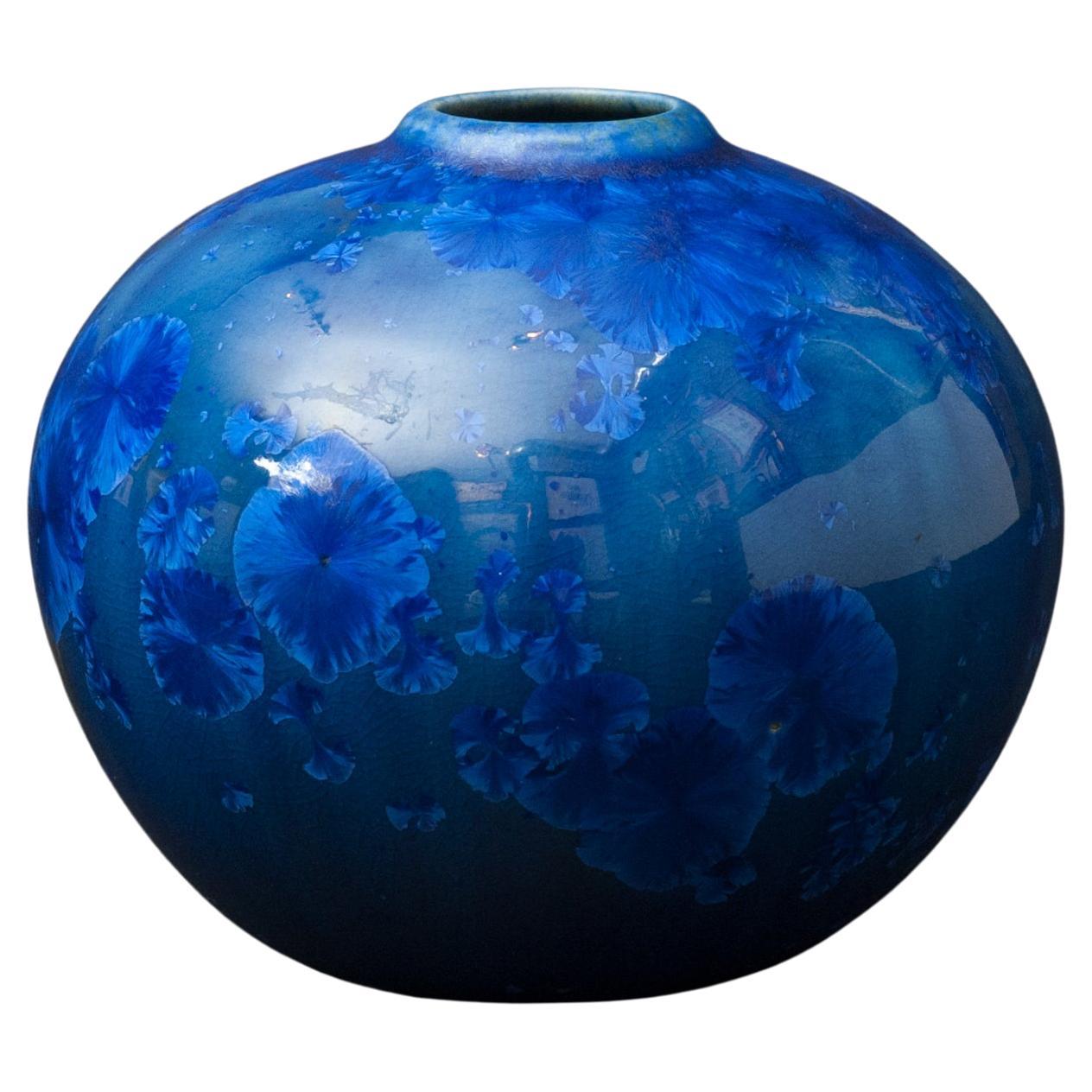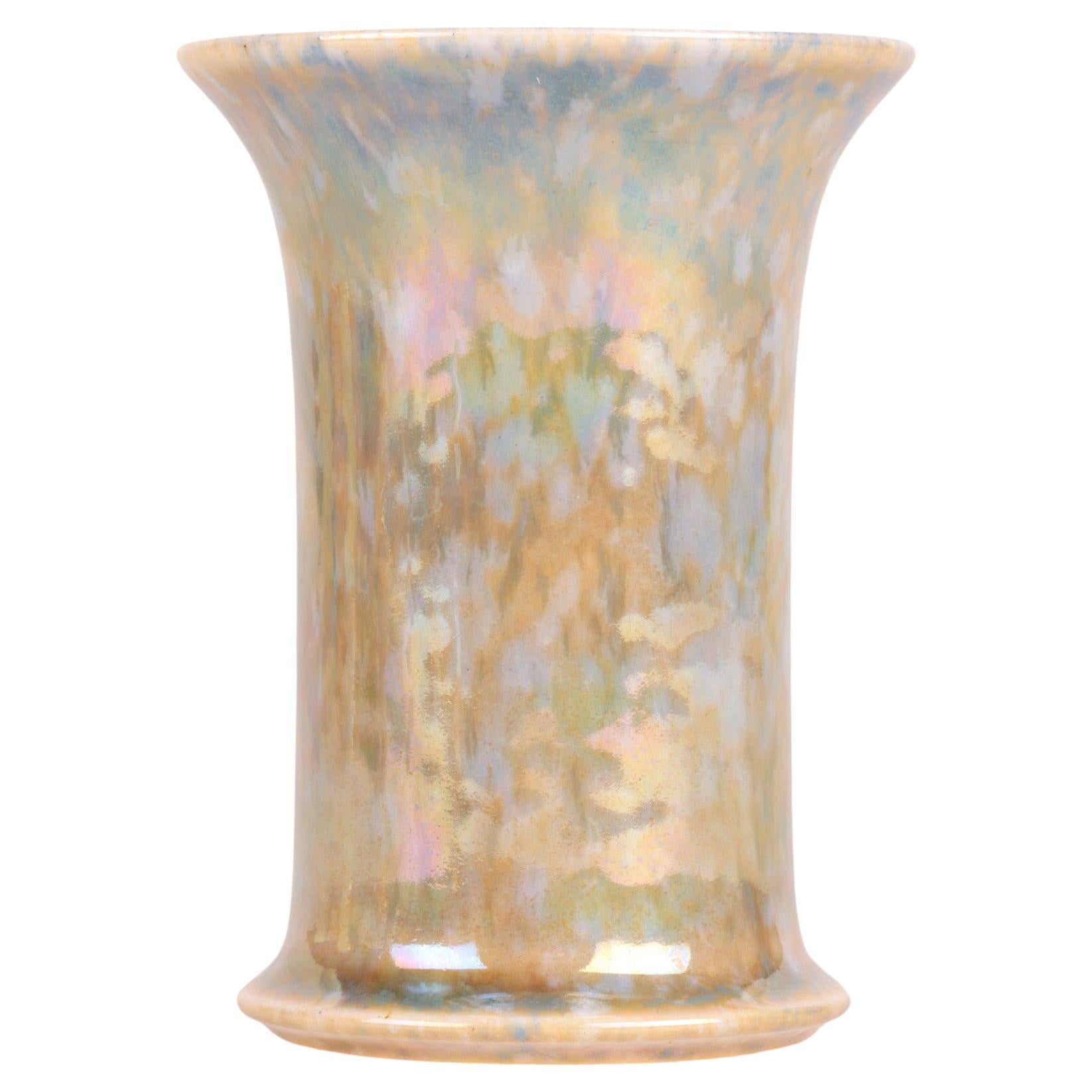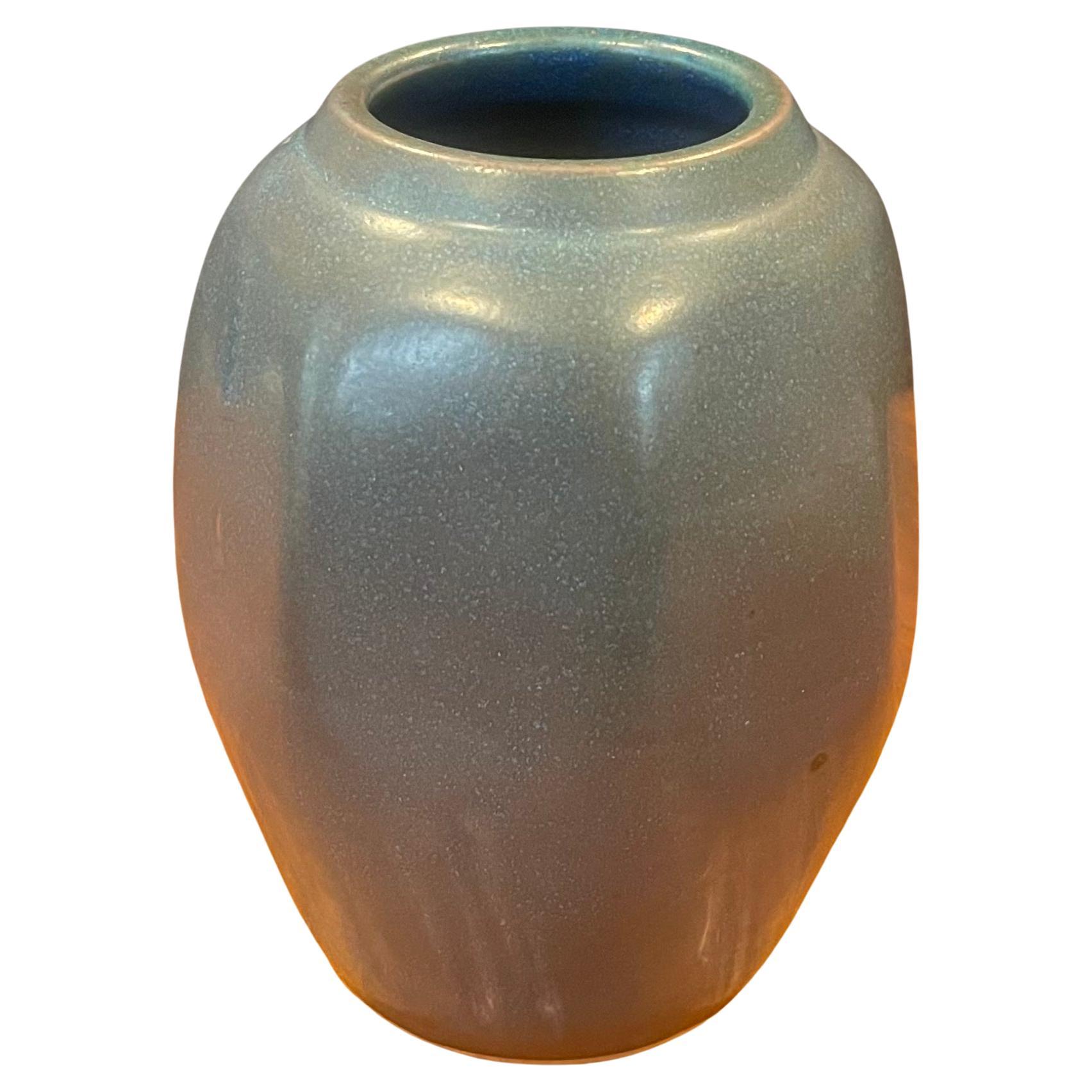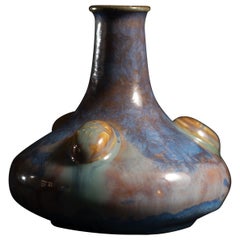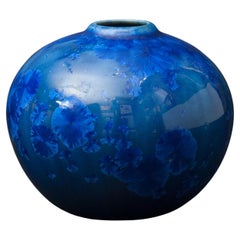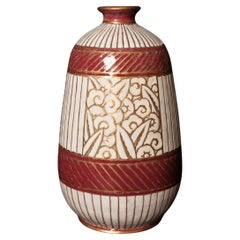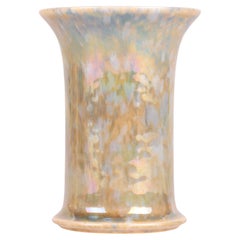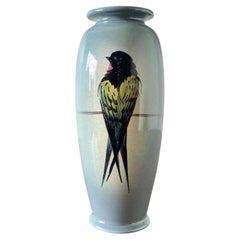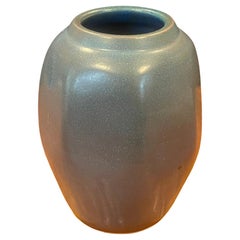Items Similar to Arts & Crafts Ochre Vase by Adelaide Alsop Robineau
Want more images or videos?
Request additional images or videos from the seller
1 of 7
Arts & Crafts Ochre Vase by Adelaide Alsop Robineau
About the Item
“A Robineau vase is a true work of art, unique in conception and perfect in execution, for every piece that left this studio was a labor of love.” – Ethel Brand Wise, The American Magazine of Art, 1929
Adelaide Alsop Robineau was a pioneer in American studio ceramics and excelled as an innovator in pottery both technically and aesthetically. As a young woman of high society in the late Victorian era, she gained early accolades as a skilled watercolorist and china painter and taught for a time at St. Mary’s Hall in Minnesota. In 1899, she married Samuel E. Robineau, a French gentleman and collector of Chinese ceramics. He was deeply intrigued by her talent and steadfastly supported and encouraged her throughout her career. The couple collaborated to produce a popular and influential monthly journal together, Keramic Studio, and went on to build a studio on their property in Syracuse, New York, which they named Four Winds. Robineau would also go on to teach for many years at Syracuse University while creating her own work and raising three children.
Early in her career, she studied at Alfred University under Charles Binns, who is widely considered to be the progenitor of contemporary studio ceramics in America. His program established a shift in the craft of ceramics as an academic pursuit, rather than one of apprenticeship. Pottery throwers and the artists who decorated the wares traditionally inhabited separate roles in ceramic manufacture, a practice common in Europe. Binns’ philosophy merged the two, such that the potter had total agency of the final product. This marked a historic divergence in the creation of art pottery – one that Adelaide Robineau fully embraced. Indeed, she became one of the first ceramists, and one of the first women, to throw her own pots.
Robineau was greatly inspired by the work and writings of Taxile Doat of Sèvres, France. As she began experimenting with clays and the high temperature method known as Grand Feu, she went from working in stoneware to porcelain. Porcelain is a notoriously technically difficult enterprise for even the simplest of pieces, and she added further complexity to the process by intricately carving many of her works, making them even more difficult to fire. The porcelain-making process was so volatile, in fact, that many of her pieces would burst in the kiln. Ever the tireless and determined innovator, she experimented with and invented many new glazes. She was, in fact, the first American ceramist to apply colored glazes to porcelain.
The period between 1909 and 1911 marks an important time in Robineau’s career when she made some of her most exceptional work. Joining other influential potters of the time such as Taxile Doat, Frederick H. Rhead, and Emile Diffloth, she was part of an impressive roster of artists working and teaching at the University City Pottery and Art Institute in Missouri. During this time, she produced what is widely considered her life’s masterpiece, the Scarab Vase – a veritable White Whale of early American ceramics – which was purchased from her husband in 1930 by the Everson Museum of Art in Syracuse, New York. This seventeen-inch tall, intricately carved magnum opus, complete with a stand and lid, took her 1,000 hours to carve, leading her to dub it The Apotheosis of the Toiler. It won her the esteemed Grand Prize in Ceramics at the 1911 International Exposition in Turin, Italy.
Robineau would go on to win several highly sought-after prizes throughout her career, and she garnered almost unanimous praise from critics, collectors, and admirers alike. At the 1915 Panama Pacific International Exposition, Helen Keller handled some of her pieces, and she was reported to have said of one with a wisteria motif: “Seven times fired in the furnace and not found wanting.” Her work was the first of the Metropolitan Museum of Art’s purchases when it began collecting American contemporary ceramics in 1922. In 1928, the year before her passing, several of her creations were represented in their International Exhibition of Ceramic Art and in 1929, after her death, she became the first ceramist honored with a retrospective exhibition there.
An artist of many firsts, Adelaide Robineau, through her passion, perseverance, and insight, left an indelible mark in the world of American ceramics. Widely recognized as a leader in her field, she left a celebrated legacy and continues to inspire collectors and potters worldwide.
- Rago
- Creator:Adelaide Alsop Robineau (Artist)
- Dimensions:Height: 8.25 in (20.96 cm)Width: 3.5 in (8.89 cm)Depth: 3.5 in (8.89 cm)
- Style:Arts and Crafts (Of the Period)
- Materials and Techniques:Porcelain,Glazed
- Place of Origin:
- Period:1910-1919
- Date of Manufacture:c. 1910
- Condition:
- Seller Location:Chicago, US
- Reference Number:1stDibs: LU7300238310242
About the Seller
5.0
Vetted Seller
These experienced sellers undergo a comprehensive evaluation by our team of in-house experts.
1stDibs seller since 2022
13 sales on 1stDibs
Typical response time: 2 hours
- ShippingRetrieving quote...Ships From: Chicago, US
- Return PolicyA return for this item may be initiated within 7 days of delivery.
Authenticity Guarantee
In the unlikely event there’s an issue with an item’s authenticity, contact us within 1 year for a full refund. DetailsMoney-Back Guarantee
If your item is not as described, is damaged in transit, or does not arrive, contact us within 7 days for a full refund. Details24-Hour Cancellation
You have a 24-hour grace period in which to reconsider your purchase, with no questions asked.Vetted Professional Sellers
Our world-class sellers must adhere to strict standards for service and quality, maintaining the integrity of our listings.Price-Match Guarantee
If you find that a seller listed the same item for a lower price elsewhere, we’ll match it.Trusted Global Delivery
Our best-in-class carrier network provides specialized shipping options worldwide, including custom delivery.More From This Seller
View AllArts & Crafts Scarab Vase by Adelaide Alsop Robineau
By Adelaide Alsop Robineau
Located in Chicago, US
“A Robineau vase is a true work of art, unique in conception and perfect in execution, for every piece that left this studio was a labor of love.” – Ethel Brand Wise, The American Magazine of Art, 1929
Adelaide Alsop Robineau was a pioneer in American studio ceramics and excelled as an innovator in pottery both technically and aesthetically. As a young woman of high society in the late Victorian era, she gained early accolades as a skilled watercolorist and china painter and taught for a time at St. Mary’s Hall in Minnesota. In 1899, she married Samuel E. Robineau, a French gentleman and collector of Chinese ceramics. He was deeply intrigued by her talent and steadfastly supported and encouraged her throughout her career. The couple collaborated to produce a popular and influential monthly journal together, Keramic Studio, and went on to build a studio on their property in Syracuse, New York, which they named Four Winds. Robineau would also go on to teach for many years at Syracuse University while creating her own work and raising three children.
Early in her career, she studied at Alfred University under Charles Binns, who is widely considered to be the progenitor of contemporary studio ceramics in America. His program established a shift in the craft of ceramics as an academic pursuit, rather than one of apprenticeship. Pottery throwers and the artists who decorated the wares traditionally inhabited separate roles in ceramic manufacture, a practice common in Europe. Binns’ philosophy merged the two, such that the potter had total agency of the final product. This marked a historic divergence in the creation of art pottery – one that Adelaide Robineau...
Category
Vintage 1910s American Arts and Crafts Vases
Materials
Porcelain
Arts & Crafts Crystalline Cerulean Vase by Adelaide Alsop Robineau
By Adelaide Alsop Robineau
Located in Chicago, US
“A Robineau vase is a true work of art, unique in conception and perfect in execution, for every piece that left this studio was a labor of love.” – Ethel Brand Wise, The American Magazine of Art, 1929
Adelaide Alsop Robineau was a pioneer in American studio ceramics and excelled as an innovator in pottery both technically and aesthetically. As a young woman of high society in the late Victorian era, she gained early accolades as a skilled watercolorist and china painter and taught for a time at St. Mary’s Hall in Minnesota. In 1899, she married Samuel E. Robineau, a French gentleman and collector of Chinese ceramics. He was deeply intrigued by her talent and steadfastly supported and encouraged her throughout her career. The couple collaborated to produce a popular and influential monthly journal together, Keramic Studio, and went on to build a studio on their property in Syracuse, New York, which they named Four Winds. Robineau would also go on to teach for many years at Syracuse University while creating her own work and raising three children.
Early in her career, she studied at Alfred University under Charles Binns, who is widely considered to be the progenitor of contemporary studio ceramics in America. His program established a shift in the craft of ceramics as an academic pursuit, rather than one of apprenticeship. Pottery throwers and the artists who decorated the wares traditionally inhabited separate roles in ceramic manufacture, a practice common in Europe. Binns’ philosophy merged the two, such that the potter had total agency of the final product. This marked a historic divergence in the creation of art pottery – one that Adelaide Robineau...
Category
Vintage 1910s American Arts and Crafts Vases
Materials
Porcelain
Arts & Crafts Blush Vase by Adelaide Alsop Robineau for University City
By Adelaide Alsop Robineau
Located in Chicago, US
“A Robineau vase is a true work of art, unique in conception and perfect in execution, for every piece that left this studio was a labor of love.” – Ethel Brand Wise, The American Magazine of Art, 1929
Adelaide Alsop Robineau was a pioneer in American studio ceramics and excelled as an innovator in pottery both technically and aesthetically. As a young woman of high society in the late Victorian era, she gained early accolades as a skilled watercolorist and china painter and taught for a time at St. Mary’s Hall in Minnesota. In 1899, she married Samuel E. Robineau, a French gentleman and collector of Chinese ceramics. He was deeply intrigued by her talent and steadfastly supported and encouraged her throughout her career. The couple collaborated to produce a popular and influential monthly journal together, Keramic Studio, and went on to build a studio on their property in Syracuse, New York, which they named Four Winds. Robineau would also go on to teach for many years at Syracuse University while creating her own work and raising three children.
Early in her career, she studied at Alfred University under Charles Binns, who is widely considered to be the progenitor of contemporary studio ceramics in America. His program established a shift in the craft of ceramics as an academic pursuit, rather than one of apprenticeship. Pottery throwers and the artists who decorated the wares traditionally inhabited separate roles in ceramic manufacture, a practice common in Europe. Binns’ philosophy merged the two, such that the potter had total agency of the final product. This marked a historic divergence in the creation of art pottery – one that Adelaide Robineau...
Category
Vintage 1910s American Arts and Crafts Vases
Materials
Porcelain
Golden Garden Vase by Odette Chatrousse-Heiligenstein
By Odette Chatrousse-Heiligenstein
Located in Chicago, US
GOLDEN GARDEN VASE, by Odette Chatrousse Heiligenstein and possibly Auguste (Claude) Theodore Heiligenstein (1891-1976)
In 2015, Brigitte Patin, the granddaughter of Auguste and Ode...
Category
Vintage 1920s French Art Deco Vases
Materials
Earthenware
Art Nouveau Porcelain Vase by Ernest Chaplet
By Ernest Chaplet
Located in Chicago, US
The Venus of Willendorf if she were a pot; this diminutive size is perfectly suited for holding in your hands. This pot is meant to be caressed. Its rather buxom top narrows at the w...
Category
Antique 1890s French Art Nouveau Vases
Materials
Enamel
Secessionist Bronze Icon Vase by Gustav Gurschner
By Gustave Gurschner
Located in Chicago, US
GUSTAV GURSCHNER (Austrian, 1873-1970), a sculptor, attended the School of Applied Arts in Vienna in 1888. Working under several artists, his time in Paris in 1897 proved to be most ...
Category
Antique Early 1900s Austrian Art Nouveau Vases
Materials
Bronze
You May Also Like
Ruskin Arts & Crafts Fine Ochre & Blue Lustre Glazed Vase
Located in Bishop's Stortford, Hertfordshire
A very finely potted Ruskin Arts & Crafts art pottery miniature vase decorated with ochre and blue lustre glazes by renowned potter William Howson Taylor (British, 1876 – 1935) dated...
Category
Vintage 1920s English Arts and Crafts Vases
Materials
Pottery
Arts & Crafts Pottery Vase By Ault
Located in Petworth, GB
Arts & Crafts glazed pottery vase
Swallow perched on a line
Ault
Circa 1895
Height 22cm. Diameter 9cm
William Ault established his English pottery firm in Staffordshire. Christo...
Category
Antique 1890s English Arts and Crafts Vases
Materials
Pottery
Vintage Arts & Crafts Style Pottery Vase
Located in San Diego, CA
Vintage "arts & crafts" style pottery vase, circa 1950s. Wonderful bluish green colors and a great vintage patina make this a wonderful decor piece! It is in very good vintage condit...
Category
Mid-20th Century American Arts and Crafts Vases
Materials
Pottery
$160 Sale Price
20% Off
Teco Pottery Arts and Crafts Architectural Vase
By Teco Art Pottery
Located in Phoenix, AZ
Teco Pottery Arts & Crafts vase with Four buttressed handles created circa 1903-1910.
This piece is designed by W.B. Mundie for Teco Pottery.
The vase is...
Category
Antique Early 1900s Arts and Crafts Vases
Materials
Pottery
Quezal Arts & Crafts Iridescent Art Glass Vase
By Quezal
Located in South Bend, IN
A gorgeous Arts & Crafts or Art Deco gold aurene art glass vase
By Quezal (signed to the underside)
USA, Circa 1920s
Measures: 3.5"W x 3.5"D x 6.13"H.
Good original vintage condi...
Category
Vintage 1920s American Arts and Crafts Vases
Materials
Art Glass
Quezal Arts & Crafts Iridescent Art Glass Vase
By Quezal
Located in South Bend, IN
A gorgeous Arts & Crafts or Art Deco blue iridescent art glass vase
By Quezal (signed on the underside)
USA, Circa 1920s
Measures: 3"W x 3"D x 7.5"H.
Good original vintage condit...
Category
Vintage 1920s American Arts and Crafts Vases
Materials
Art Glass
Recently Viewed
View AllMore Ways To Browse
Arts And Crafts Motif
American Arts And Crafts Motifs
Ochre Fields
Samuel Hall
Chinese Studio Pottery
Antique Furnaces
Antique China Porcelain Collectibles
Chinese Pots With Lids
Antique China Brands
Sevres China
Carved Scarab
Scarab Motif
Victorian Pot Lids
Porcelain Chinese Woman
Clay Pot Stands
Tall Magazine Stand
Sevres Pot
Adelaide Antique Furniture
